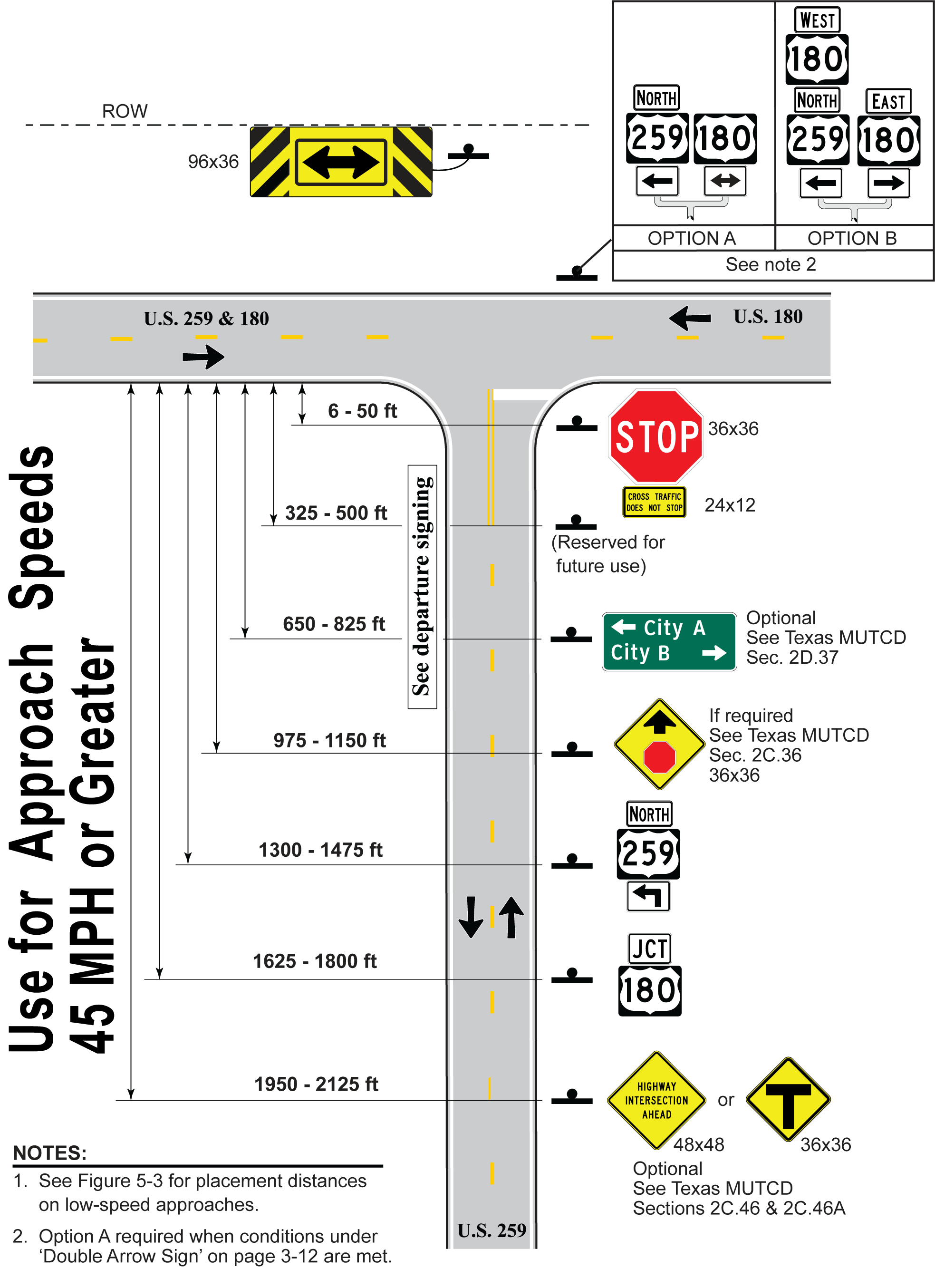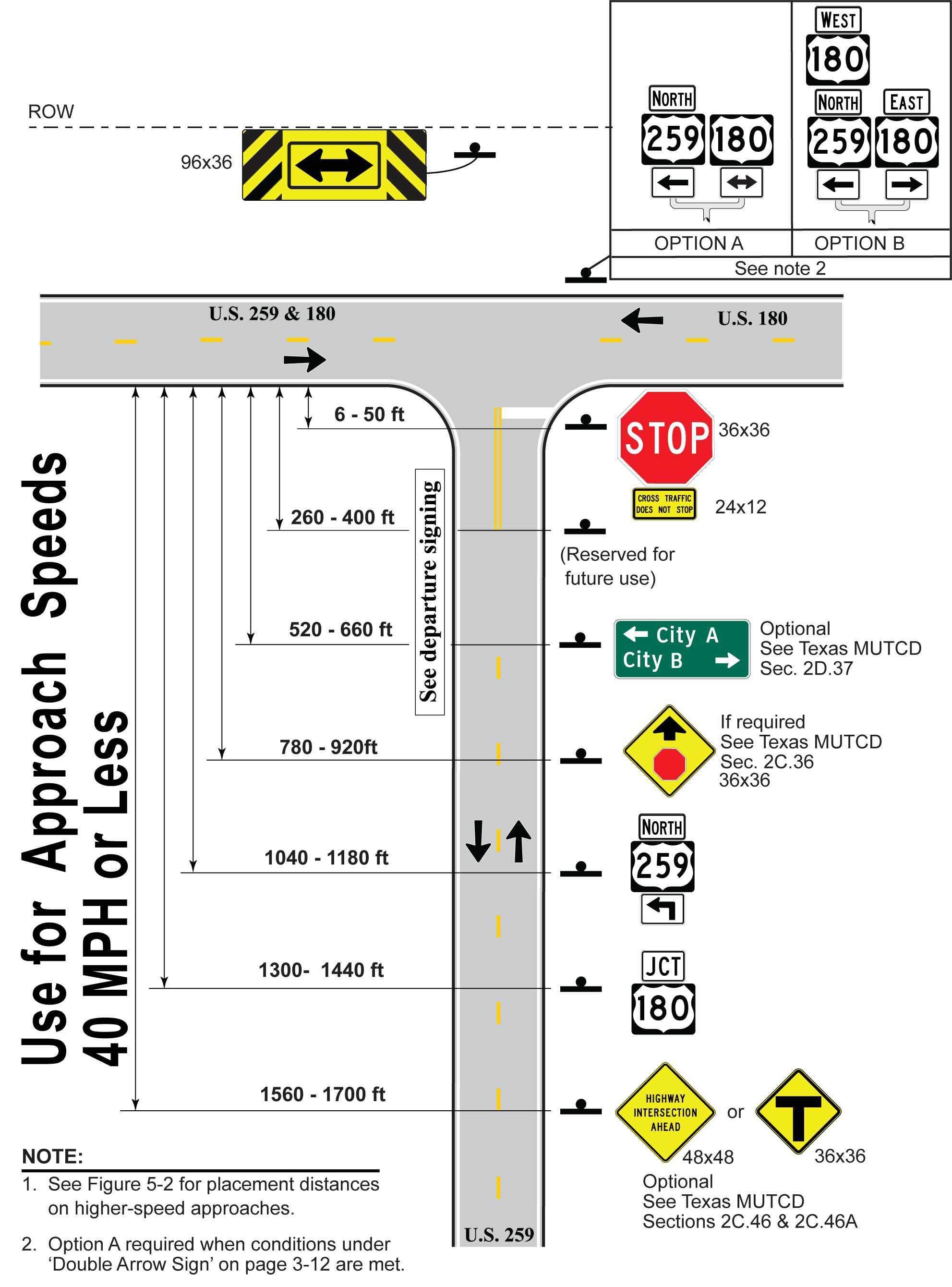Section 2: Basic Placement Considerations
Anchor: #i1005100Introduction
The figures in this chapter indicate the placement of signs located on the approach to an intersection.
- Anchor: #JAPBCHTM
- Special Note on Approach Placement Distances: A given sign type should remain approximately the same distance from the intersection in all applications. For example, the Junction assembly should always be 1625-1800 ft from the intersection when the speed limit is ≥ 45 mph. A given type of sign should not be moved closer to the intersection when a sign type closer to the intersection is not used. For example, the Junction assembly should not be moved closer to the intersection if the Advance Route Turn assembly is not used.
Convention Used in Illustrations
The illustrations contained in this chapter utilize several conventions to simplify the information being presented in the figures.
- Anchor: #QMLDHQXK
- Use of Highway Classifications and Numbers in Illustrations - The highway intersections illustrated in this field book are not intended to represent specific intersections in the state. For simplicity, only one highway class is used for all highways in the illustrations, and no more than six different route numbers are used. The six highway numbers used in the illustrations are three-digit U.S. Highway numbers: U.S. 180, U.S. 259, U.S. 290, U.S. 281, U.S. 377, and U.S. 380. Anchor: #VOPVDPIO
- Reference Points for Placement Distances - The distance shown in the figures is the distance between the sign installation and the near edge of the intersecting roadway. Figures 5-2 and 5-3 illustrate the application of this convention, and Table 5-1 contains the placement distances for each type of sign that could be used on an approach to an intersection. Anchor: #ESVMSTFC
- Cross-References to the Texas MUTCD - Where it is appropriate, notes in the figures refer to material in the Texas MUTCD related to the use of a specific sign. These cross-references are typically provided to help the user determine whether a sign should be used in a particular situation. Anchor: #CAYMCIUC
- Figure Symbol Boxes Description - Each of the figures shown in Sections 3, 4, and 5 has a symbol box located in the lower right-hand corner of the figure. The purpose of these boxes is to assist in quickly determining what is illustrated in a particular figure. These symbol boxes represent the intersection geometrics, routing arrangement, and type of traffic control devices used in the intersection. Each of these symbol boxes has two basic sections. The left most section contains the type of traffic control device used at the intersection, such as a Stop sign, a traffic signal, or no control. The right most section contains the sketch of the intersection geometry and routing arrangement for the intersection. The arrows in the right section of the box represent the intersection routing arrangement. They show the direction the assigned routes are going or in some cases ending. For example, the symbol box in Figure 5-1 illustrates the following: the left-hand section of the symbol box tells that a Stop sign with Cross Traffic Does Not Stop plaque is used as the traffic control device. Likewise, in the right-hand section of the symbol box, is shown having a routing arrangement that consists of the approach route going left.
Figure 5-1. Example of Symbol Box
Figure 5-2. Convention for Sign Placement Distances on High-Speed Approach
Figure 5-3. Convention for Sign Placement Distances on Low-Speed Approach
Anchor: #i1005178Effect of Speed on Placement Distances
The posted speed is the primary criteria for the longitudinal placement of signs. Speed is divided into low-speed roadways (speed ≤ 40 mph) and high-speed roadways (speed ≥ 45 mph).
The distances shown in the figures in this chapter are for highways with speeds of 45 mph or greater. For highways with speeds of 40 mph or less, signs may be placed closer to the intersection. Table 5-1 identifies the high-speed and low-speed placement distances for each type of sign that could be used on an approach to an intersection.
|
Placement Distance for Speed Condition1 (Distance from near edge of intersecting roadway) |
Type of Sign |
|
|---|---|---|
|
Low-Speed (≤ 40 mph), ft2 |
High-Speed (≥45 mph) ft3 |
|
|
6-50 |
6-50 |
Directional Assembly or Stop Sign |
|
260-400 |
325-500 |
Reserved for Future Use |
|
520-660 |
650-825 |
Destination Sign |
|
780-920 |
975-1150 |
Advance Traffic Control Sign |
|
1040-1180 |
1300-1475 |
Advance Route Turn Assembly |
|
1300-1440 |
1625-1800 |
Junction Assembly |
|
1560-1700 |
1950-2125 |
Highway Intersection Sign or Intersection Warning Sign |
|
Notes: 1A sign installation should not be moved closer to the intersection if another sign is not used. In other words, the Junction assembly should always be 1625-1800 ft from the intersection, even if the Advance Route Turn assembly is not installed. 2Generally rounded to the nearest 10 ft. 3Generally rounded to the nearest 25 ft. |
||
Anchor: #i1005199
Approach Placement Illustrations
The illustrations in this chapter illustrate typical sign placements for various intersection designs. The intersections present the following types of information:
- Anchor: #RAYXWRXW
- Geometry:
-
Anchor: #YGKIBVMJ
- 3-leg T (Chapter 5, Section 3) Anchor: #WLADWWXU
- 3-leg side (Chapter 5, Section 4) Anchor: #FOAWBEKM
- 4-leg (Chapter 5, Section 5).
Anchor: #PMFSRELF - Number of Approach Lanes:
- Anchor: #YAOKMEGK
- 1 approach lane alone Anchor: #DAYUDTRG
- 1 approach lane with left-turn lane Anchor: #RXEJGXPA
- 2 approach lanes alone Anchor: #IEGRYXNV
- 2 approach lanes with left-turn lane.
Anchor: #DFTAODAW - Type of Control:
-
Anchor: #LRJVTJYK
- No control on approach Anchor: #UWMTPNWP
- Stop or Yield control on approach Anchor: #NXEMHIJU
- Signal control on approach.
Anchor: #UHAISSYH - Highway Routing Arrangement:
- Anchor: #VYHESUVO
- Numbered highway ends at intersection Anchor: #COWOHGMN
- Numbered highway turns right or left at intersection Anchor: #GIGVWBWP
- Highway continues through intersection Anchor: #LBUENLML
- Any two or more of the above arrangements.
Table 5-2 is an index that indicates how the approach characteristics shown above are incorporated into the figures in this chapter.
|
Fig. No. |
Geometry |
Number of Approach Lanes |
Type of Control |
Routing Arrangement |
|||||||||||
|---|---|---|---|---|---|---|---|---|---|---|---|---|---|---|---|
|
3-leg T |
3-leg Side |
4-leg |
1 Ln. |
1 Ln. + LT |
2 Ln. |
2 Ln. + LT |
None |
Stop |
Signal |
Ends |
Left |
Thru |
Right |
Other |
|
|
5-4 |
√ |
|
|
√ |
|
|
|
|
√ |
|
|
√ |
|
|
|
|
5-5 |
√ |
|
|
√ |
|
|
|
|
√ |
|
|
√ |
|
|
|
|
5-6 |
√ |
|
|
√ |
|
|
|
|
√ |
|
√ |
|
|
|
|
|
5-7 |
√ |
|
|
√ |
|
|
|
|
|
√ |
|
|
|
√ |
|
|
5-8 |
√ |
|
|
√ |
|
|
|
|
√ |
|
|
√ |
|
√ |
|
|
5-9 |
√ |
|
|
|
|
√ |
|
|
|
√ |
|
|
|
√ |
|
|
5-10 |
|
√ |
|
√ |
|
|
|
√ |
|
|
|
|
√ |
|
|
|
5-11 |
|
√ |
|
√ |
|
|
|
√ |
|
|
|
√ |
√ |
|
|
|
5-12 |
|
√ |
|
|
√ |
|
|
√ |
|
|
|
√ |
√ |
|
|
|
5-13 |
|
√ |
|
|
|
√ |
|
√ |
|
|
|
√ |
√ |
|
|
|
5-14 |
|
√ |
|
√ |
|
|
|
|
|
√ |
|
|
√ |
|
√ |
|
5-15 |
|
√ |
|
|
√ |
|
|
|
|
√ |
|
|
√ |
|
√ |
|
5-16 |
|
√ |
|
|
|
|
√ |
|
|
√ |
|
|
√ |
|
√ |
|
5-17 |
|
|
√ |
√ |
|
|
|
|
√ |
|
|
|
√ |
|
|
|
5-18 |
|
|
√ |
√ |
|
|
|
√ |
|
|
|
|
√ |
|
|
|
5-19 |
|
|
√ |
√ |
|
|
|
|
√ |
|
|
√ |
√ |
|
|
|
5-20 |
|
|
√ |
√ |
|
|
|
|
|
√ |
|
|
√ |
|
|
|
5-21 |
|
|
√ |
√ |
|
|
|
|
|
√ |
|
|
√ |
√ |
|
|
5-22 |
|
|
√ |
√ |
|
|
|
|
|
√ |
|
√ |
√ |
|
|
|
5-23 |
|
|
√ |
|
|
√ |
|
√ |
|
|
|
|
√ |
|
|
|
5-24 |
|
|
√ |
|
√ |
|
|
|
|
√ |
|
|
√ |
|
√ |
|
5-25 |
|
|
√ |
√ |
|
|
|
|
√ |
|
√ |
|
|
|
|
|
5-26 |
|
|
√ |
√ |
|
|
|
|
√ |
|
|
√ |
|
|
|
|
5-27 |
|
|
√ |
√ |
|
|
|
|
√ |
|
|
√ |
|
√ |
|
|
5-28 |
|
|
√ |
√ |
|
|
|
|
|
√ |
|
|
|
√ |
|
|
5-29 |
|
|
√ |
√ |
|
|
|
|
|
√ |
|
√ |
|
√ |
|


